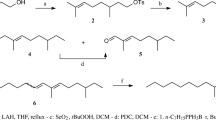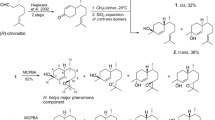Abstract
Field survey of the geometrical isomers of 7,9-dodecadienyl alcohol, acetate, and aldehyde has resulted in attractants and inhibitors for three species of tortricid moths.Epinotia silvertoniensis and an undescribedEpinotia sp. were all attracted to (Z,Z)-7,9-dodecadienyl acetate. AnotherEpinotia sp. was attracted to (Z,Z)-7,9-dodecadienyl acetate and (Z,Z)-7,9-dodecadien-1-ol. Electroantennogram data and inhibition patterns for one of theEpinotia sp. are also reported. In addition,E. criddleana was attracted to lures containing (E)-9-dodecenyl acetate.
Similar content being viewed by others
References
Booij, C.J.H., andVoerman, S. 1984. New sex attractants for 35 tortricid and 4 other Lepidopterous species, found by systematic field screening in the Netherlands.J. Chem. Ecol. 10:135–144.
Chisholm, M.D., Steck, W.F., Arthur, A.P., andUnderhill, E.W., 1975. Evidence forcis-11-hexadecen-1-ol acetate as a major component of the sex pheromone of the bertha armyworm,Mamestra configurata (Lepidoptera: Noctuidae).Can. Entomol. 107:361–366.
Chisholm, M.D., Steck, W.F., Bailey, B.K., andUnderhill, E.W. 1981. Synthesis of sex pheromone components of the forest tent caterpillarMalacosoma disstria (Hubbner) and of the western tent caterpillar,Malacosoma californicum (Packard).J. Chem. Ecol. 7:159–163.
Chisholm, M.D., Reed, D.W., Underhill, E.W., Palaniswamy, P., andWong, J.W. 1985. Attraction of tortricid moths of the subfamily Olethreutinae to field traps baited with dodecadienes.J. Chem. Ecol. 11:217–230.
Corey, E.S., andSuggs, J.W. 1975. Pyridinium chlorochromate. An efficient reagent for oxidation of primary and secondary alcohols to carbonyl compounds.Tetrahedron Lett. 31:2647–2650.
Frérot, B., Priesner, E., andGallois, M. 1979. A sex attractant for the green budworm moth,Hedya nubiferana.Z. Naturforsch 34C:1248–1252.
Hill, A.S., Berisford, C.W., Brady, U.E., andRoelofs, W.L. 1981. The Nantucket pine tip moth,Rhyacionia frustrana: Identification of two sex pheromone components.J. Chem. Ecol. 7:517–528.
Hodges, R.W., et al. 1983. Checklist of the Lepidoptera of America North of Mexico. E.W. Classey Limited and the Wedge Entomological Research Foundation, University Press, Cambridge, Great Britain.
Houx, N.W., Voerman, S., andJongen, W.M. 1974. Purification and analysis of synthetic insect sex attractants by liquid chromotography on a silver-loaded resin.J. Chromatogr. 96:25–32.
Palaniswamy, P., Chisholm, M.D., Underhill, E.W., Reed, D.W., andPeesker, S.J. 1983. Disruption of forest tent caterpillar (Lepidoptera: Lasiocampidae) orientation to baited traps in aspen groves by air permeation with (5Z,7E)-5,7-dodecadienal.J. Econ. Entomol. 76:1159–1163.
Preisner, E. 1979a. Specificity studies on pheromone receptors of noctuid and tortricid lepidoptera, pp. 57–71,in F.J. Ritter (ed.). Chemical Ecology: Odour Communication in Animals. Elsevier/North-Holland Biomedical Press, Amsterdam.
Preisner, E. 1979b. Progress in the analysis of pheromone receptor systems.Ann. Zool. Ecol. Anim. 11:533–546.
Preisner, E. 1983. Receptors for diunsaturated pheromone analoges in the male summerfruit tortrix moth.Z. Naturforsch. 38c:874–877.
Reed, D.W., Chisholm, M.D., andUnderhill, E.W. 1984. Sex attractant for three species of the genusOncocnemis: O. chandleri (GRT.),O. cibalis (GRT.), andO. mackiei (B and Benj) (Lepidoptera: Noctuidae)J. Chem. Ecol. 10:1701–1706.
Roelofs, W.L., andBrown, R.L. 1982. Pheromones and evolutionary relationships of Tortricidae.Annu. Rev. Ecol. Syst. 13:395–422.
Roelofs, W.L., andComeau, A. 1969. Sex pheromone specificity: Taxonomic and evolutionary aspects in Lepidoptera.Science 165:398–400.
Roelofs, W., Kochansky, J., Carde, R., Arn, H., andRauscher, S. 1973. Sex attractant of the grape vine moth,Lobesia botrana.Mitt. Schweiz. Entomol. Ges. 46:71–73.
Steck, W.F., Underhill, E.W., Chisholm, M.D., Bailey, B.K., Loeffler, J., andDevlin, C.G. 1977. Sex attractants for males of 12 moth species found in western Canada.Can. Entomol. 109:157–160.
Steck, W.F., Chisholm, M.D., Bailey, B.K., andUnderhill, E.W. 1979. Moths sex attractants found by systematic field testing of 3-component acetate-aldehyde candidate lures.Can. Entomol. 111:1263–1269.
Steck, W.F., Underhill, E.W., andChisholm, M.D. 1982. Structure activity relationships in sex attractants for North America noctuid moths.J. Chem. Ecol. 8:731–754.
Author information
Authors and Affiliations
Rights and permissions
About this article
Cite this article
Reed, D.W., Chisholm, M.D. Field trapping of threeEpinotia species with (Z,Z)-7,9-dodecadienyl acetate (Lepidoptera: Tortricidae). J Chem Ecol 11, 1389–1398 (1985). https://doi.org/10.1007/BF01012139
Received:
Accepted:
Issue Date:
DOI: https://doi.org/10.1007/BF01012139




